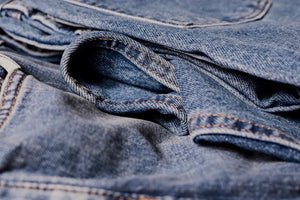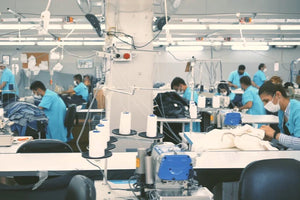What is organic cotton?
Jul 12, 2019
Around half of all clothing worldwide is made from cotton. In order to increase the yield of cotton cultivation, producers often use processes that are harmful to people and the environment. TORLAND only uses cotton from environmentally friendly organic cultivation for its jeans.
| Organic cotton | Conventional cotton | |
| Seeds | Natural, untreated seeds | Often genetically modified seeds, usually treated with fungicides or insecticides |
| Floor | Healthy soil through mixed culture; thicker humus layer stores more water | Soil erosion due to monoculture; requires intensive irrigation |
| fertilization | Natural fertilizer such as manure or compost | Artificial fertilizers, usually unaffordable for small farmers |
| Weed control | Healthy soil creates natural balance; mixed culture keeps weeds away | Use of herbicides that pollute the soil |
| Pest control | Use of trap plants, beneficial organisms and biological agents | Aerial spraying of insecticides and pesticides, some of which are carcinogenic |
| harvest | Manual harvesting guarantees high quality | Defoliation by toxic chemicals, followed by mechanical harvesting leads to reduced quality |
When industrially produced cotton is grown, pesticides, herbicides, artificial fertilizers and defoliants are used, which pollute the soil, groundwater and air we breathe and disrupt the ecological balance. This form of cultivation leads to soil erosion, which means that cultivation requires much more water than uncontaminated soil. During further processing into yarn and fabric, the cotton is cleaned and washed several times. This means that most of the chemicals end up in the wastewater. However, certain residues can even be found in the end product.
In recent years, more and more people have become aware of the problems associated with such cultivation methods. This has led to an increased demand for organically grown products. In organic farming, only natural means of fertilization and pest control may be used. In addition, organically produced cotton products are considered to be of particularly high quality. This is because no chemicals are used in organic farming that could destroy the cotton fibers. Organic cotton therefore has longer fibers. This affects the quality of the fabric, which feels finer and is also more durable than conventional cotton fabric.
The main differences between organic cotton and conventional cotton are explained below.
Genetically modified seeds versus natural seeds
Conventional cotton is often grown from genetically modified seeds. This change is intended to make the cotton plant more resistant to pests. Unfortunately, many pests adapt to these "power" plants, which means that even larger quantities of pesticides have to be used. In China and India, up to 90% of the cotton plants grown are genetically modified. In contrast, the use of genetically modified seeds is prohibited in organic farming. Only natural cotton seeds may be used.
Monocultures versus mixed cultures
In industrial cultivation, cotton plants are grown in a monoculture. This means that only pure cotton is planted in the fields. This cultivation strategy leads to high crop losses when pests attack, which is why large quantities of pesticides are sprayed as a precaution. Since the soil next to the cotton plants is unprotected, it is prone to greater erosion. The natural weather washes away more and more of the humus layer. The soil then has a lower water storage capacity due to the thinner humus layer, which means that significantly more water is needed for cultivation. This is critical in regions that have few natural water sources.
Organic cotton, on the other hand, is usually grown as a mixed crop. There are several reasons for this. On the one hand, no artificial fertilizers may be used in organic farming. This is why organic farming relies on a healthy layer of humus. On the other hand, natural methods of pest control must be used in organic farming. Often, so-called trap plants are planted next to the cotton, which are more likely to attack the pests than the cotton. This mixed crop protects the soil because it is planted over the entire area.
|
Cotton monoculture (Image: Kimberly Vardeman , Flickr, CC BY 2.0 ) |
Cotton mixed culture (Photo: Peretz Partensky , Flickr, CC BY-SA 2.0 ) |
Natural versus artificial fertilizer
In order to increase yields, up to 360 kg of chemical fertilizers are used to produce one kilogram of cotton. Over time, soil fertility decreases, so that cultivation is only possible with artificial fertilizers. This makes farmers dependent on expensive artificial fertilizers. This is a major problem in developing countries. Many small farmers cannot afford the expensive artificial fertilizers.
In organic farming, artificial fertilizers are completely avoided. The prerequisite is healthy soil with a sufficient layer of humus. Manure or compost is used for fertilization. In recent years, more and more small farms have switched to organic farming.
Herbicides versus natural weed control
In order to remove unwanted weeds, conventional cotton production relies on the use of herbicides. These are sometimes toxic chemicals that reduce the quality of the cotton and pollute the soil. These chemicals include carcinogenic substances. The regular use of these substances exposes farmers to a high health risk, not to mention the fatal consequences for the environment. Organic cotton farmers, on the other hand, remove the weeds by hand. Organic cultivation through mixed crops is also less susceptible to weeds.
Pesticides versus natural pest control
Large quantities of pesticides are used in industrial cultivation, including highly toxic insecticides and carcinogens (cancer-causing substances). On average, 6 kg of pesticides are sprayed on a 4000 m2 field per year. Compared to other agricultural products, the most pesticides are used in cotton cultivation.
When growing organic cotton, no chemicals are used at all. Pests are controlled by using natural enemies, such as other insects, or so-called trap plants. These are plants that are planted next to the cotton and which are more likely to attack the pests. In addition, natural agents made from garlic, onions and chili are sprayed.
Water consumption
As a result of soil erosion, industrial cotton cultivation requires a lot of water. Up to 25,000 liters of water are needed to produce one kilogram of cotton. With organic farming methods, the soil can store an average of 30% more water, meaning that the fields need to be irrigated less often. This is particularly important in regions with water shortages.
Mechanical versus manual harvesting
In conventional cotton cultivation, the ripe cotton bolls are harvested with large machines. In order for this to be possible, the plants must be completely defoliated. To do this, chemical defoliants are sprayed on the plants. The chemicals used are similar to those used in the Vietnam War. In contrast, in organic cultivation, the cotton is mostly picked by hand. Therefore, the fields do not have to be artificially defoliated.
During mechanical harvesting, both ripe and unripe bolls are harvested at the same time. This has an impact on the quality. The cotton is less pure and the fibers are of lower quality than during manual harvesting, where only ripe cotton bolls are harvested. Organic cotton therefore has a higher degree of purity and the fibers are of higher quality. This means that organic cotton clothing feels softer than conventional cotton products. In addition, the better fiber quality of organic cotton means that the products last longer.
|
Mechanical harvesting (Image: Kimberly Vardeman , Flickr, CC BY 2.0 ) |
Manual harvest (Photo: Chris Shervey , Flickr, CC BY 2.0 ) |
Further processing of cotton
Before the cotton can be processed into yarn, it must be cleaned. This washes out most of the chemicals from the conventionally grown cotton. But even after several washes, residues can lead to allergies or skin irritations. Such skin problems are not uncommon. But customers rarely associate this with the ingredients of their own clothing.
Since no hazardous substances are used to produce organic cotton, there are no dangerous residues in the clothing.
Certification of organic cotton
Independent certification organizations ensure that organic producers only use methods and materials that are permitted for organic production. There are currently two international organic certificates: GOTS (Global Organic Textile Standard) and OCS (Organic Content Standard), whereby GOTS, in contrast to OCS, covers not only the cultivation but also the further processing of the cotton and certain social standards. At TORLAND we generally use fabrics that have been manufactured according to the GOTS standard. TORLAND itself is also GOTS certified .
Sources:
- https://sleepsherpa.com/organic-cotton-vs-regular-cotton-whats-difference/
- https://www.swedishlinens.com/blogs/news/organic-vs-conventional-cotton
- https://www.organiccottonaccelerator.org/portfolio-item/oca-supports-cross-sector-initiatives-dutch-sustainable-textiles-convenant-cotton-2040/
- https://www.fibl.org/fileadmin/documents/en/development-cooperation/production-systems/cotton-training-manual-transparencies.pdf
- https://thenaturalsleepstore.com/blog/post/organic-cotton.html
- https://www.tagblatt.ch/panorama/boese-jeans-gute-jeans-eins-der-schaedlichsten-produkte-was-hinter-der-herstellung-von-jeans-steckt-ld.931025








